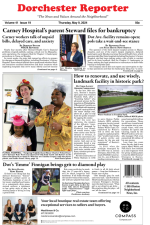October 24, 2007
Susan Abner, who lives on Mather Street near Fields Corner, is a professional pet groomer. She runs her own store, Snippers Hair Club for Dogs, on Dorchester Ave. in South Boston.
So, when Susan spotted a coyote prowling her street last Friday morning around 7:30 a.m., she knew it was not a dog. Out for her morning constitutional with her bijou, Abner spotted the scruffy, white-furred animal as it lept from a stone wall on the sidewalk and started towards her. She scooped up her tiny dog - and the family cat that was tagging along nearby - and got them in the house pronto.
"He was a big one, about 80 pounds. He looked like a scrappy German Shepherd, white. But you could tell he was definitely not a dog," she said.
Abner soon learned that she was not the only one to spot the coyote in recent days. Peter Sasso, who lives on nearby Centervale Park, said he saw the coyote running along Upland Ave. around the same time on Saturday morning. Paul Robinson, president of the Melville Park Association, reports that the animal was sighted three times again on Sunday in the same area.
When Abner called Boston authorities to report her sighting, she was surprised to find that they were not alarmed by the news.
"They said, 'Oh, that's normal,'" Abner said.
Jennifer Mehigan, a spokesperson for Mayor Tom Menino, says that Animal Control officers typically do respond to calls of coyote sightings when they come in.
"Our guys do go out and see if it's a public safety risk. If it needs to be shot, that does happen. It's rare," Mehigan says. "Generally they are only coming for food or trash."
Tom O'Shea, a coyote specialist who is an assistant director of wildlife for the state's Division of Fisheries and Wildlife, says that unless an animal is showing certain aggressive behaviors, there is no need for local authorities to even be called.
"If a coyote is approaching people or attacking pets on a leash, that would be a concern," said O'Shea. "When they try to prey on small cats or dogs, that behavior is normal. Especially cats at night.
"I know there is a period where this feels unfamiliar or uncomfortable. But [coyotes] are in every city and town in the Commonwealth, except Martha's Vineyard and Nantucket. We have to learn how they live and we need to modify our behavior accordingly."
That includes keeping better track of your pets, he advises, particularly small dogs and cats. Don't leave food out in the yard for your pets and, of course, never deliberately feed the coyotes.
This time of year, O'Shea says, juvenile coyotes might start straying into new territory that is not occupied by other coyotes. Sometimes, they will travel in small packs.
In the instance that one may seem aggressive, O'Shea says that Boston's animal control office or the local police department should be alerted.
"It's very rare. We don't get [those calls] very often," said O'Shea.
There have been incidents, however, that give neighborhood people pause. Last December, a Mattapan man watched helplessly as a coyote snatched up his teacup Yorkshire terrier while he was walking in a wooded area along River Street, near the Mattapan Heights development. Two other coyote-bites-dog incidents have been reported in Hyde Park and Jamaica Plain in the last three years. No reports of human attacks have been reported in the city and are rare even in rural parts of the state.
The state's Division of Fisheries and Wildlife maintain a website devoted to coyotes. It can be viewed at www.mass.gov/dfwele/dfw/wildlife/living/living_with_coyotes.htm.



